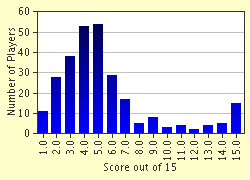Quiz Answer Key and Fun Facts
1. The Madhyamaka ('Middle-Way') school of Mahayana Buddhism is regarded as the elucidation of the philsophy of which corpus of texts?
2. Which of the following is NOT an English cognate of the Sanskrit words deriving from the root j˝a, e.g. vij˝ana ('consciousness') and praj˝a and j˝ana (both 'wisdom').
3. Finish the second line of the following verse.
"Whatever is dependently co-arisen
That is explained to be __________.
That, being a dependent designation,
Is itself the middle way."
4. The previous verse, from the XXIVth chapter of the "Mulamadhyamakakrika" (or "Madhyamakasatra"), is one of the most essential of the entire text. Who is the author of this seminal text?
5. In modern scholarship, what hasn't Madhyamaka philosophy been interpreted as?
6. In the first chapter of his commentary on Nagarjuna's "Madhyamakasatra", Candrakirti criticizes his Buddhist compatriots Dignaga and Bhavaviveka. However Candrakirti does NOT rebuke Bhavaviveka for which of the following reasons?
7. The doctrine of the two truths is distinctive of Madhyamaka philosophy. The two truths are paramarthasatya (ultimate truth) and samvrtisatya (universal truth). According to Candrakirti's analysis in "Prasannapada", there are three definitions of samvrti. Which of the following is NOT one of them?
8. According to a famous verse by Nagarjuna, emptiness mistakenly understood is not a good thing. He likens it to a spell mistakenly cast and what else?
9. According to Nagarjuna emptiness is NOT which of the following?
10. The Yogacara school of Mahayana philosophy, also know as Vij˝anavada and Cittamatra, is often characterized as a Buddhist brand of what?
11. Which of the following is NOT one of the three natures according to Vasubandhu?
12. The perfected nature is which of the following?
13. Which of the following figures is NOT commonly associated with Yogacara school of Buddhist philosophy?
14. Although Yogacara is generally regarded as one form of idealism or another, it is also credited with the development of Buddhist logic as well as for having made major contributions to logic and epistemology in South Asia in general. However the two major figures associated with these developments are not Vasubandhu and Asanga. Who are they?
15. Santaraksita and his student Kamalasila, seminal figures in the reinvigoration of Buddhism in Tibet, are major figures in the synthesis of various schools of Indian Buddhist philosophy that would come to characterize Tibetan Buddhism. According to Tibetan doxography, what is the appropriate denotation of their position?
Source: Author
gti mug pa
This quiz was reviewed by FunTrivia editor
trammgr before going online.
Any errors found in FunTrivia content are routinely corrected through our feedback system.


